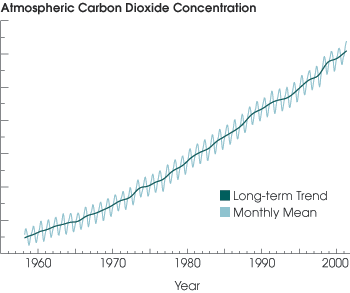Greenhouse effect
Climate Change
Kyoto Protocol
Links
Some gases in the atmosphere produce the "greenhouse effect",
trapping the heat of Earth without allowing it to escape in the outer
space.
The greenhouse effect is normally natural and beneficial
: without it Earth would be at least 15 ° C colder; it is becoming more
and more important due to the increasing concentration of these gases
("greenhouse gases") in the atmosphere due to human activity.
The main
greenhouse gases are : carbon dioxide (CO2) , methane,
nitrous oxide (N2O), chlorofluorocarbons (CFCs); also water
vapour (H2O) is producing the greenhouse effect.
Carbon dioxide
The concentration of the most important greenhouse gas, carbon dioxide, has increased in the atmosphere from 290 ppmv (parts per millions by volume) in 1880 to about 380 ppmv in 2006, and is going to increase in the next future, because carbon dioxide, with water, is the final product of the combustion of fossil fuels (oil and derivatives, methane and hydrocarbons, coal), and of living and dead vegetation (biomass burning). The fossil fuels can be considered reservoirs of carbon, made ages ago; their combustion lets carbon return (as dioxide) into the atmosphere, increasing the greenhouse effect.
Carbon dioxide is easily soluble in water : the oceans contain
enormous amounts of it, but the temperature increase ( due to the
greenhouse effect) reduces its water solubility, releasing new gas
into the atmosphere, and accelerating the greenhouse effect.

( Image from NASA:
CO2 concentration in the atmosphere
)
What will be the main consequences of greenhouse
effect ?
There is no dispute about the human responsibility on the greenhouse
effect, but much is still debated on its possible consequences.
The
most authoritative studies have been carried out on behalf of UN by IPCC
(Intergovernmental Panel on Climate Change); according to a report by this
Committee, underwritten by hundred of scientists (IPCC WGI Third
Assessment Report - SPM, issued in January 2001) , the Earth is really
warming :
- the global average surface temperature has
increased over the 20th century by about 0.6 °C .
Globally, it is very
likely that the 1990s was the warmest decade and 1998 the warmest
year in the instrumental record, since 1861 .
- According to British scientists, 2005 has been the warmest year in the Northern Hemisphere, and the second warmest globally since 1861.
- Satellite data show decreases of about 10% in the extent of
snow cover since the late 1960s. In particular equatorial snows and
glaciers are disappearing quickly, on the Peruvian Ands and in Africa (33%
of Kilimanjaro ices has melted over the past 20 years); the
thickness of Arctic sea-ice in late summer is
decreased.
- Warming of the whole Anctartica has not been
demonstrated; but in West Anctartica, specially in the Antarctica
Peninsula (southern of the Latin America), massive landslides of enormous
icy areas forming icebergs are observed. It is not clear if this process
is related to the greenhouse effect or if it is the result of regional
climatic changes.

Image from the Modis satellite, by Nasa
(An
enormous ice sheet, 3250 sqkm wide, collapses from Larsen B platform,
Antarctica Peninsula, forming icebergs;
March 19,
2002)
-Global average sea level has risen, mainly due to the thermal
expansion of seas ( ice retreat is not the main reason): the increase over
the 20th century has been between 10 and 20 centimeters.
Global Climatic Trend : Projections until 2100.
The projections of the IPCC, carried out with greatly improved methods
compared to the past, indicate big increase in atmospheric
CO2 concentration due to human activity, with
significant climatic consequences :
- The
globally averaged surface temperature is projected to increase by 1.4 to
5.8°C over the period 1990-2100: the rate of warming, too, should increase
compared to last century.
Warming should be most
notable in some areas of our planet (northern regions of North America,
northern and central Asia).
- Heat waves, droughts, drier
soils.
- Increased evaporation and precipitation due to higher
energy in the atmosphere : more frequent and extreme weather events (
storms, tornados, hurricanes ).
-Sea levels will go on
raising: erosion of sandy beaches or flooding of coastal areas (e.g.,
Bangla Desh, Nile Delta) and small islands (specially the atolls in South
Pacific).
-Easier transmission of some infectious diseases,
including malaria and yellow fever .
How long will Climate Change last ?
The emissions of the most persistent greenhouse gases (carbon
dioxide, nitrogen protoxide, perfluorocarbons) have a lasting effect on
the climate : e.g., about a quarter of carbon dioxide persists in the
atmosphere several centuries after the emission.
Even if greenhouse
gases concentration could be stabilized, the average surface temperatures
and sea level would go on rising for centuries, due to the fact that
deep Oceans follow climatic variations with big delay.
Actions against greenhouse effect
-
The following actions have been suggested to reduce greenhouse gas effect:
-
- Energy saving ; using energy renewable sources (sun, wind, hydropower, geothermal, biomasses) or, among fossil fuels, prefer natural gases to oil or coal ( light hydrocarbons combustion is producing less carbon dioxide).
-
- Gradual elimination of CFCs , see our page about Ozone Depletion
-
- Planting new forests, saving the old ones.
-